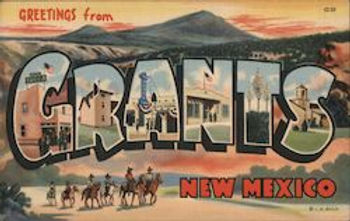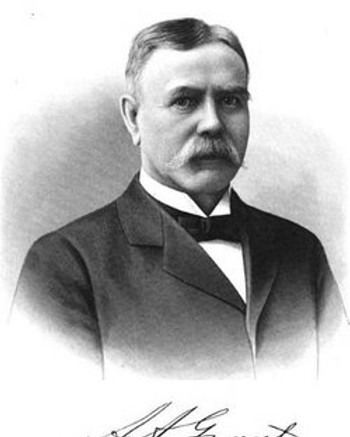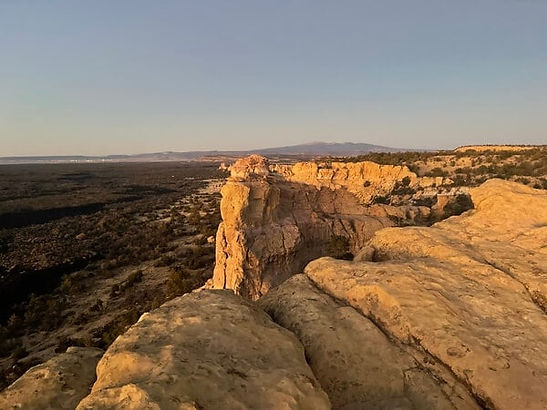








Atlantic & Pacific Railroad
1880-1912
The A&P has a rich history in the United States. Its earliest predecessor was the Pacific Railroad, which was established by the Missouri General Assembly in 1849 with the goal of connecting St. Louis and a point south of Kansas City across the center of the state.
In 1852, the federal government passed a law granting public lands to Missouri for the construction of two cross-state railroads. In response, the state approved an amendment to the 1849 Pacific Railroad law in December 1852, which added a Southwest Branch that would receive the grants. The new branch started from Franklin, Missouri (now Pacific) on the main line and headed west-southwesterly across the state. By 1860, construction on 71 miles (114 km) from Franklin to Dillon was completed, and a further 6 miles (9.7 km) to Rolla were opened in 1861. The company graded 12 more miles (19 km) to Arlington. However, due to defaulting on bonds, the state seized the road from Franklin to Rolla and the incomplete roadbed to Arlington in March 1866. The property was later sold in June for $1.3 million to explorer and politician John C. Frémont, who reorganized it as the Southwest Pacific Railroad in September. It's important to note that the main line of the Pacific Railroad was not sold and would later become the Missouri Pacific Railroad.
In July 1866, Congress incorporated the Atlantic and Pacific Railroad, which was to be managed by Frémont and his associates. The company was authorized to build a railroad near the 35th parallel from Springfield, Missouri, westward to the Pacific Ocean and also a branch from Van Buren, Arkansas. The railroad was promised land grants along its route, provided it was completed by 1878. The same conditions were imposed on the Southern Pacific Railroad of California, which could build a branch to connect to the A&P near the eastern border of the state.
In January 1867, the A&P acquired the Southwest Pacific and laid rails on the grade to Arlington. However, the company failed to make its payments, and as a result, the state of Missouri seized the property in June 1867. It was later sold to a new South Pacific Railroad in July 1868, and ownership of the A&P was also transferred to the new owners, which included Clinton B. Fisk of St. Louis.
By 1870, another 164 miles (264 km) to Pierce City and 39 miles (63 km) of grading to Seneca on the state line had been completed. Later that same year, the South Pacific sold its property to the A&P. The A&P laid rails to Neosho and Seneca, and extended beyond to Vinita, Oklahoma in 1871. The Pacific (later Missouri Pacific) Railroad, which operated a line to Kansas City and several branches, including several into Kansas, was leased by A&P in June 1872. The A&P's only branch, a 1.5-mile (2.4 km) line to a mine near Granby, Missouri, was built in 1875.In January of 1880, the SL&SF (St. Louis and San Francisco) Railroad came to an agreement with the Atchison, Topeka, and Santa Fe Railroad. The two companies would jointly control the A&P (Atlantic and Pacific) Railroad. The SL&SF would continue to operate the Central division, while a new Western division would begin on the AT&SF at Isleta, New Mexico, and run west to meet the Southern Pacific at Needles, California. Construction began that same year and reached Kingman, Arizona, in 1882.
In the 1880s, Grants came into existence as a railroad camp. Three brothers, Angus A. Grant [1], John R. Grant, and Lewis A. Grant, were given the contract to build a part of the Atlantic and Pacific Railroad through the area. Initially, the camp was called Grants Camp, then Grants Station, and finally Grants. The new city was formed around the tracks of the Atlantic and Pacific Railroad, which engulfed the existing colonial New Mexican settlement of Los Alamitos. The town flourished due to railroad logging in the nearby Zuni Mountains and became a section point for the Atlantic and Pacific Railway, which later merged with the Atchison, Topeka, and Santa Fe Railway.
In January 1899, the AT&SF railroad acquired trackage rights over the SP's Tehachapi Pass line via the Santa Fe Pacific. This gave the AT&SF access to the Central Valley of California and the San Francisco Bay Area, with the Santa Fe Pacific operating through the SF&SJV trackage into Bakersfield after leaving the SP at Kern Junction. By July 1902, the AT&SF had purchased the Santa Fe Pacific Railroad property, and in December 1911, its subsidiary, California, Arizona, and Santa Fe Railway, bought the Southern Pacific line between Mojave and Needles. However, the Santa Fe Pacific Railroad continued to own its land grants from the A&P. As of 2007, the Santa Fe Pacific still existed as a subsidiary of the Burlington Northern Santa Fe Corporation, which succeeded the AT&SF.
The Atlantic and Pacific Railroad (A&P) operated through trackage rights over the AT&SF from Isleta to Albuquerque. The A&P also leased the Southern Pacific to Mojave. However, in December 1893, both the AT&SF and the SL&SF, which the former had gained control of in 1890, entered receivership. The A&P followed suit in January 1894, and as a result, the A&P's Western division was sold to the newly created AT&SF subsidiary, Santa Fe Pacific Railroad, in June 1897. The remaining Central division was sold under foreclosure to the reorganized SL&SF, which became independent of the AT&SF in December 1897. This ended the A&P's existence.
In the 1880s, Grants emerged as a railroad camp. Three brothers, Angus A. Grant, John R. Grant, and Lewis A. Grant, were given the contract to build a part of the Atlantic and Pacific Railroad through the area. The camp was initially called Grants Camp, then Grants Station, and finally Grants. The new city was formed around the tracks of the Atlantic and Pacific Railroad, which engulfed the existing colonial New Mexican settlement of Los Alamitos. The town thrived due to railroad logging in the nearby Zuni Mountains and became a section point for the Atlantic and Pacific Railway, which later merged with the Atchison, Topeka, and Santa Fe Railway.
In 1883, the Southern Pacific began building a railroad branch from Mojave, California, which ran east to Needles. The two railroads met on August 9, 1883. The AT&SF leased the line from the Southern Pacific a year later. In November 1885, the AT&SF-owned California Southern Railroad completed its line over Cajon Pass to the Southern Pacific's Needles branch at Barstow. This gave the AT&SF access to the coast.
The AT&SF acquired trackage rights in January 1899 over the SP's Tehachapi Pass line via the Santa Fe Pacific. This gave the AT&SF access to the Central Valley of California and the San Francisco Bay Area. The Santa Fe Pacific operated through the SF&SJV trackage into Bakersfield after leaving the SP at Kern Junction. By July 1902, the AT&SF had purchased the Santa Fe Pacific Railroad property. In December 1911, its subsidiary, California, Arizona, and Santa Fe Railway, bought the Southern Pacific line between Mojave and Needles. However, the Santa Fe Pacific Railroad continued to own its land grants from the A&P. As of 2007, the Santa Fe Pacific still existed as a subsidiary of the Burlington Northern Santa Fe Corporation, which succeeded the AT&SF.
The gap across Oklahoma, Texas, and New Mexico was eventually closed in 1904 when the Arkansas Valley and Western Railway, a subsidiary of SL&SF, completed its line from Tulsa to Avard, Oklahoma, on the AT&SF's line through the Texas Panhandle. In 1995, the AT&SF merged with SL&SF successor Burlington Northern Railroad to form the BNSF Railway, which still operates the line as a main line.

Angus A. Grant [1]
President, Grant Brothers railway
Angus A. Grant was born on October 4, 1843, in Charlottenburgh, Stormont, Dundas, and Glengarry United Counties, Ontario, Canada. He was the oldest of three brothers who owned the Grant Brothers' railway building firm, the others being Lewis A. Grant and John Grant. Angus A. Grant passed away on July 20, 1901, in Albuquerque, Bernalillo County, New Mexico Territory, USA.
During the late 1800s, the area surrounding Grants Camp had plenty of water, which attracted many homesteaders to farm the region. Others grazed cattle and sheep on nearby ranches or took advantage of the plentiful logging opportunities.
The Town of Grants in New Mexico was named after the Grant Brothers in 1880. The railway company's camp for workers was called Grants Camp. The railway itself was also named Grant, and the post office had the same name from 1882 to 1935. In Spanish, the name Grantes was used. In 1936, the post office changed the name to Grants.
In 1882, the post office was established with the name of Grants, but the population continued to call the settlement Grant’s Camp. Later, when the Railroad Station was built, that changed to Grant’s Station, and in 1936, the town’s official name was changed to Grants.
Although it remained mostly a quiet farming community, Grants took advantage of the many travelers who came through town when Route 66 was built. Motels and services soon opened right up against the railroad tracks, many of which still operate in the present day.

1880
GRANTS, NEW MEXICO
Uranium Capital of the World




GRANTS

GRANTS STATION

1880 $1000 bond for completion of
the Atlantic and Pacific Railroad Company - Western Division.
Atlantic & Pacific Railroad Co. (Western Division) $1000 Bond dated 1880 Source: The Cooper Collection of Early American Railroadiana

1881
GRANT'S, NEW MEXICO
Uranium Capital of the World




GRANTS

GRANT'S CAMP
1881 Photo of a Section House for the railroad workers working on the
Atlantic and Pacific Railroad that
was contracted by Angus A. Grant, John R. Grant, and Lewis A. Grant
who established Grant's Camp,
New Mexico Territory "present
day Grants, New Mexico".
Grant's Camp located on the
north side of the Rio San Jose
and nearby Los Alamitos

which was established by Jesus Blea in 1872
on the south side of the Rio San Jose "present
day San Jose Drive, Grants, New Mexico.
1881 Section House for the Atlantic & Pacific Railroad, West Grant, New Mexico-Valencia County. Photo by Ben Wittick

1881
GRANTS, NEW MEXICO
Uranium Capital of the World




GRANTS

GRANT'S CAMP
1881 Photo of a Section House for the railroad workers working on the
Atlantic and Pacific Railroad that
was contracted by Angus A. Grant, John R. Grant, and Lewis A. Grant
who established Grant's Camp,
New Mexico Territory "present
day Grants, New Mexico".
Grant's Camp located on the
north side of the Rio San Jose
and nearby Los Alamitos

which was established by Jesus Blea in 1872
on the south side of the Rio San Jose "present
day San Jose Drive, Grants, New Mexico.
1881 Section House for the Atlantic & Pacific Railroad, West Grant, New Mexico-Valencia County. Photo by Ben Wittick

1883
GRANT'S, NEW MEXICO
Uranium Capital of the World




GRANTS

GRANT'S CAMP
1883 Transcontinental Route for the Atlantic & Pacific Railroad Co. G.W.
& C.B. Colton & Co. - This map is available from the United States Library of Congress's
Geography & Map Division under
the digital ID g3701p.rr003300.

1883 Atlantic and Pacific Railroad Company
map of the New Transcontinental Route,
prepared by G. W. and C. B. Colton & Co. 182 WIlliam Street, New York

1897
GRANT'S, NEW MEXICO
Uranium Capital of the World




GRANTS

GRANTS STATION
A&P PASSENGER TRAIN NO. 2 ROBBED AND WRECKED BY BANDITS AT GRANT'S

NOVEMBER 7, 1897



Allegheny County Reporter
Wellsville, New York
NOVEMBER 9, 1897





1880 $1000 bond for completion of
the Atlantic and Pacific Railroad Company - Western Division.
Section Title
Credits and Sources
-
Atlantic and Pacific Railroad - Wikipedia
-
This Is Grants/Milan New Mexico